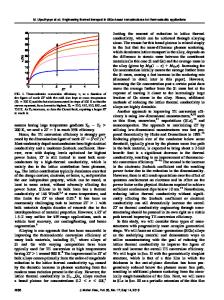Tuning transport properties of nickel-doped zinc oxide for thermoelectric applications
- PDF / 528,768 Bytes
- 7 Pages / 612 x 792 pts (letter) Page_size
- 63 Downloads / 317 Views
Research Letter
Tuning transport properties of nickel-doped zinc oxide for thermoelectric applications Andrei Baranovskiy, Ido Koresh, and Yaron Amouyal, Department of Materials Science and Engineering, Technion—Israel Institute of Technology, Haifa 32000, Israel Address all correspondence to Yaron Amouyal at [email protected] (Received 31 January 2018; accepted 4 May 2018)
Abstract ZnO-based oxides are promising for thermoelectric energy generation at elevated temperatures. We study electrical transport properties of Nidoped ZnO applying the density functional theory, indicating increase of the electrical conductivity (σ) and decrease of the Seebeck coefficient (S) due to Ni-doping, in full accordance with experimental results. We calculate the temperature-dependent σ and S applying the Boltzmann transport theory, approximating the electron relaxation time, τe. Good agreement with experimental data is obtained considering both temperature and energy dependence of τe. This yields explicit expressions for τe and provides us with powerful predictive tool assessing electronic transport in ZnO.
Introduction Reducing air pollution and carbon dioxide emission is of great scientific and technologic essence. Thermoelectric (TE) power generation technology enables direct conversion of waste heat into electrical power, and is probably one of the most promising directions in this avenue. A temperature gradient applied on TE materials induces charge carrier diffusion, which in turn gives rise to electrical voltage between the hot and cold poles, thus converting heat flux into electrical power. TE devices are compact with no moving parts, noiseless, and environmentally safe.[1] A typical TE device comprises several n- and p-type modules connected electrically in series and thermally in parallel; it is, therefore, of great technologic importance to develop both types of TE materials. Nowadays, the commonly used TE materials are chalcogenide-based compounds such as PbTe,[2,3] which are expensive and unstable at elevated temperatures. Conversely, TE oxides exhibit significant benefits having structural and chemical stability over a wide temperature range. They are also environmentally friendly and relatively inexpensive.[4] They exhibit, however, a major shortcoming, that is, their relatively low performance. The dimensionless “figure of merit”, ZT, expressed by: ZT =
S 2 sT , ke + kl
(1)
denotes the thermodynamic conversion efficiency of a TE material. Here T is the absolute temperature, S is the Seebeck coefficient, σ is the electrical conductivity, and κe and κl are the electronic and lattice components of thermal conductivity, respectively. The TE “power factor” (PF) is defined by S2σ.
Typical oxides are characterized by ZT values ranging between 0.1 (e.g., CaMnO3) and 0.3 (e.g., Al-doped ZnO) for elevated temperatures.[1,4,5] The highest ZT values of p-type layered cobalt oxides, such as NaxCo2O4[6,7] and Ca3Co4O9,[8] approach 1 at 1000 K, whereas those of the best n-type TE oxides barely exceed 0.8.[5,7] It is, therefore,
Data Loading...










